This week we are pleased to welcome Dr. Natalie Cabrol, Director of the Carl Sagan Center for Research at the SETI Institute (SI), to the show.
Continue reading “Weekly Space Hangout: October 28, 2020, Dr. Nathalie Cabrol, SETI Institute”Weekly Space Hangout: October 21, 2020, Dr. Jill Tarter and the Search for Technosignatures
This week we are excited (and honored) to welcome Dr. Jill Tarter to the Weekly Space Hangout. Best known for her work in the field of SETI, tonight Jill will be discussing the search for technosignatures.
Continue reading “Weekly Space Hangout: October 21, 2020, Dr. Jill Tarter and the Search for Technosignatures”Weekly Space Hangout: May 13, 2020 – Dr. Seth Shostak from the SETI Institute
This week we are pleased to welcome Seth Shostak to the Weekly Space Hangout. Seth is Senior Astronomer and Institute Fellow at the SETI Institute. With degrees in physics and astronomy from Princeton University and Caltech, he has a long history of research in radio astronomy and in the Search for Extraterrestrial Intelligence, or SETI.
Continue reading “Weekly Space Hangout: May 13, 2020 – Dr. Seth Shostak from the SETI Institute”Lava Tube Openings Found Near the Moon’s North Pole
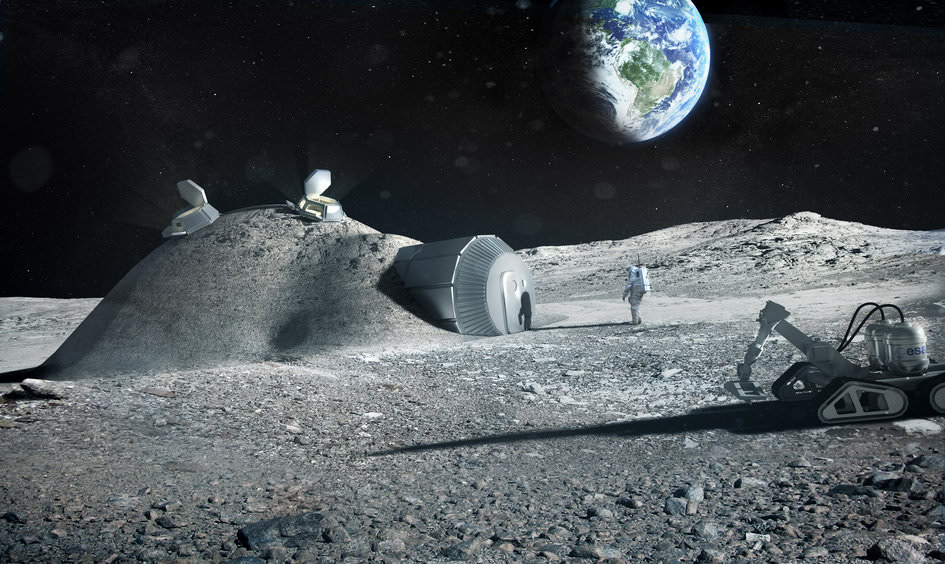
Between NASA, the Chinese National Space Agency, the European Space Agency and Roscosmos, there’s no shortage of plans for returning to the Moon and creating a permanent base there. Naturally, these plans have given rise to questions of where such bases should be built. So far, the top contenders have been lava tubes that have been spotted in various locations across the surface of the Moon and in the polar regions.
Whereas the polar regions are permanently shaded and appear to have abundant ice water, stable lava tubes would offer protection against the elements and harmful radiation. However, according to a new discovery presented at NASA’s Lunar Science for Landed Missions Workshop, it appears that there is a location on the Moon that ticks off both boxes – a possible lava tube that is located in the norther polar region!
This discovery was detailed in an abstract titled “Philolaus Crater: Exploring Candidate Lava Tubes And Skylights Near The Lunar North Pole“. The author was Pascal Lee, the co-founder and chairman of the Mars Institute, a planetary scientist at the SETI Institute, and the Principal Investigator of the Haughton-Mars Project (HMP) at NASA’s Ames Research Center.
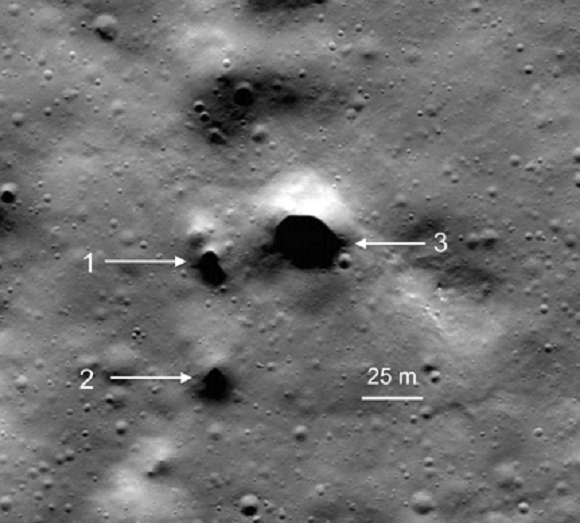
These pits were identified based on an analysis of imaging data from NASA’s Lunar Reconnaissance Orbiter (LRO). These images indicated the presence of small pits in the northeastern floor of the Philolaus Crater, a 70 km (43 mi)-diameter impact crater located about 550 km (340 mi) from the Moon’s North Pole. These pits could potentially be “skylights”, holes in the surface that lead to subterranean recesses.
Each pit appears to be a rimless depression measuring roughly 15 to 30 meters (50 to 11 ft) across and have shadowed interiors. Moreover, the pits are located along winding channels known as “sinous rilles” that are present along the floor of the Philolaus Crater. On the moon, these channels are thought to be the result of subterranean lava tubes that have since collapsed, or partially collapsed.
If water ice is present in the region, then these skylights could allow future explorers access to subsurface water ice that is less tainted by regolith. This presents a number of opportunities for research, and future long-term missions to the lunar surface. As Pascal Lee explained:
“The highest resolution images available for Philolaus Crater do not allow the pits to be identified as lava tube skylights with 100 percent certainty, but we are looking at good candidates considering simultaneously their size, shape, lighting conditions and geologic setting.”
In recent years, over 200 pits have been discovered by other researchers on the Moon, many of which were identified as possible skylights leading to underground lava tubes. However, this latest discovery is the first to place a possible skylight and lava tube within the Moon’s polar regions. These regions have become the focal point of research in recent years due to the fact that water ice is known to exist in the polar regions.
Within these permanently-shadowed cratered regions – particularly the South Pole-Aitken Basin – water ice is known to exist within the regolith. As a result, multiple proposals have been made to create lunar bases in the polar regions. However, there remains the challenge of how to get to that water (which would require drilling) and the fact that a permanently-shadowed region would not allow access to solar power.
This new discovery is therefore exciting for three reasons. For one, it would allow for much easier access to lunar polar ice that would be much more pure than anything drilled from the surface. Second, solar power would be available nearby, just outside each skylight. And third, these openings could provide access to a stable lava tube that contains water ice itself, much as lava tubes on Earth do.
Philolaus Crater also offers two additional bonuses when it comes a lunar settlement. Given that the crater formed in the Copernican Era (i.e. the last 1.1 billion years) it is relatively young as lunar craters go. As such, it would offer scientists with plenty of opportunities to study the Moon’s more recent geological history. Also, since the Philolaus Crater is on the near-side on the Moon, it would allow direct communications with Earth.
And as Lee added, a base in this location would also allow for some amazing views:
“We would also have a beautiful view of Earth. The Apollo landing sites were all near the Moon’s equator, such that the Earth was almost directly overhead for the astronauts. But from the Philolaus skylights, Earth would loom just over the crater’s mountainous rim, near the horizon to the southeast.”
Looking ahead, Lee and his colleagues indicate that further exploration is needed to verify whether or not these pits are lava tube skylights and whether or not they contain ice. In the future, astronauts and robots could be sent to the polar regions of the Moon in order to seek out and explore caves that have been identified from orbit. As Lee explained, this will have benefits that go far beyond lunar exploration.
“Exploring lava tubes on the Moon will also prepare us for the exploration of lava tubes on Mars,” he said. “There, we will face the prospect of expanding our search for life into the deeper underground of Mars where we might find environments that are warmer, wetter, and more sheltered than at the surface.”
And as Bill Diamond – president and CEO of the SETI Institute – explained, this discovery highlights the true nature of exploration, which goes well beyond orbiters and robotic explorers:
“This discovery is exciting and timely as we prepare to return to the Moon with humans. It also reminds us that our exploration of planetary worlds is not limited to their surface, and must extend into their mysterious interiors”.
The Lunar Science for Landed Missions Workshop was convened by the Solar System Exploration Research Virtual Institute (SSERVI) at NASA’s Ames Research Center. The purpose of the workshop was to examine the range of scientific investigations that could be conducted on the Moon, including in-situ science, network science and sample return missions.
Further Reading: SETI
Project Blue: Building a Space Telescope that Could Directly Observe Planets Around Alpha Centauri
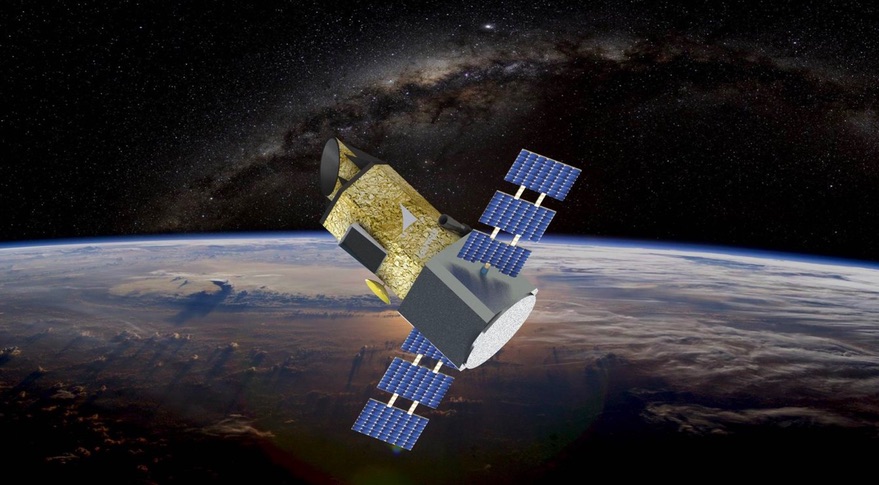
In the past few decades, thousands of exoplanets have been discovered in neighboring star systems. In fact, as of October 1st, 2017, some 3,671 exoplanets have been confirmed in 2,751 systems, with 616 systems having more than one planet. Unfortunately, the vast majority of these have been detected using indirect means, ranging from Gravitational Microlensing to Transit Photometry and the Radial Velocity Method.
What’s more, we have been unable to study these planets up close because the necessary instruments do not yet exist. Project Blue, a consortium of scientists, universities and institutions, is looking to change that. Recently, they launched a crowdfunding campaign through Indiegogo to finance the development of a space telescope that will start looking for exoplanets in the Alpha Centauri system by 2021.
In addition to its commercial and academic partners, Project Blue is a collaborative effort between the BoldlyGo Institute, Mission Centaur, the SETI Institute, and the University of Massachusetts Lowell. It is steered by a Science & Technology Advisory Committee (STAC) composed of science and technology experts who are dedicated to space exploration and the search for life in our Universe.
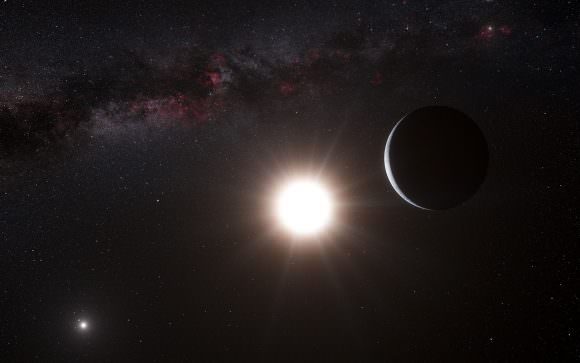
To accomplish their goal of directly studying exoplanets, Project Blue is seeking to leverage recent changes in space exploration, which include improved instruments and methodology, the rate at which exoplanet have been discovered in recent years, and increased collaboration between the private and public sector. As SETI Institute President and CEO Bill Diamond explained in a recent SETI press statement:
“Project Blue builds on recent research in seeking to show that Earth is not alone in the cosmos as a planet capable of supporting life, and wouldn’t it be amazing to see such a planet in our nearest neighboring star system? This is the fundamental reason we search.”
As noted, virtually all exoplanet discoveries that have been made in the past few decades were done using indirect methods – the most popular of which is Transit Photometery. This method is what the Kepler and K2 missions relied on to detect a total of 5,017 exoplanet candidates and confirm the existence of 2,470 exoplanets (30 of which were found to orbit within their star’s habitable zone).
This method consists of astronomers monitoring distant stars for periodic dips in brightness, which are caused by a planet transiting in front of the star. By measuring these dips, scientists are able to determine the size of planets in that system. Another popular technique is the Radial Velocity (or Doppler) Method, which measures changes in a star’s position relative to the observer to determine how massive its system of planets are.
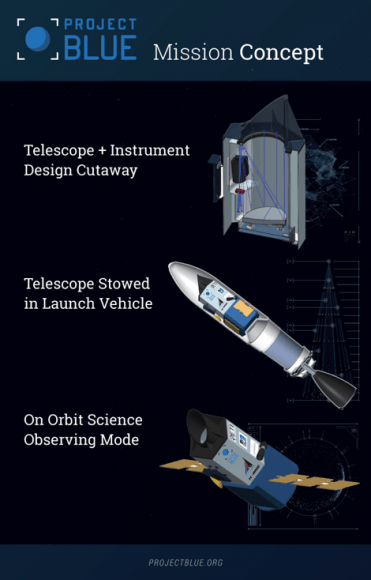
These and other methods (alone or in combination) have allowed for the many discoveries that have been made to take place. But so far, no exoplanets have been directly imaged, which is due to the cancelling effect stars have on optical instruments. Basically, astronomers have been unable to spot the light being reflected off of an exoplanet’s atmosphere because the light coming from the star is up to ten billion times brighter.
The challenge has thus become how to go about blocking this light so that the planets themselves can become visible. One proposed solution to this problem is NASA’s Starshade concept, a giant space structure that would be deployed into orbit alongside a space telescope (most likely, the James Webb Space Telescope). Once in orbit, this structure would deploy its flower-shaped foils to block the glare of distant stars, thus allowing the JWST and other instruments to image exoplanets directly.
But since Alpha Centauri is a binary system (or trinary, if you count Proxima Centauri), being able to directly image any planets around them is even more complicated. To address this, Project Blue has developed plans for a telescope that will be able to suppress light from both Alpha Centauri A and B, while simultaneously taking images of any planets that orbit them. It’s specialized starlight suppression system consists of three components.
First, there is the coronagraph, an instrument which will rely on multiple techniques to block starlight. Second, there’s the deformable mirror, low-order wavefront sensors, and software control algorithms that will manipulate incoming light. Last, there is the post-processing method known as Orbital Differntial Imaging (ODI), which will allow the Project Blue scientist to enhance the contrast of the images taken.
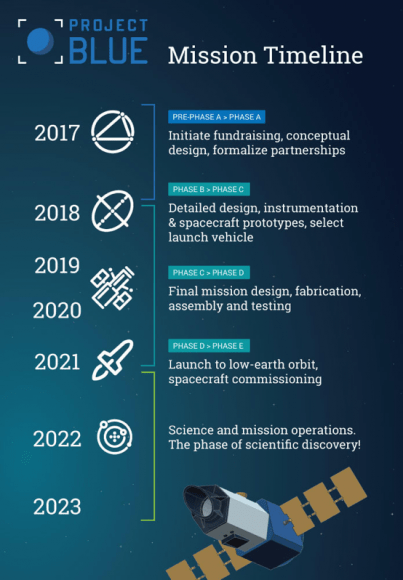
Given its proximity to Earth, the Alpha Centauri system is the natural choice for conducting such a project. Back in 2012, an exoplanet candidate – Alpha Centauri Bb – was announced. However, in 2015, further analysis indicated that the signal detected was an artefact in the data. In March of 2015, a second possible exoplanet (Alpha Centauri Bc) was announced, but its existence has also come to be questioned.
With an instrument capable of directly imaging this system, the existence of any exoplanets could finally be confirmed (or ruled out). As Franck Marchis – the Senior Planetary Astronomer at the SETI Institute and Project Blue Science Operation Lead – said of the Project:
“Project Blue is an ambitious space mission, designed to answer to a fundamental question, but surprisingly the technology to collect an image of a “Pale Blue Dot” around Alpha Centauri stars is there. The technology that we will use to reach to detect a planet 1 to 10 billion times fainter than its star has been tested extensively in lab, and we are now ready to design a space-telescope with this instrument.”
If Project Blue meets its crowdfunding goals, the organization intends to deploy the telescope into Near-Earth Orbit (NEO) by 2021. The telescope will then spend the next two years observing the Alpha Centauri system with its corongraphic camera. All told, between the development of the instrument and the end of its observation campaign, the mission will last six years, a relatively short run for an astronomical mission.

However, the potential payoff for this mission would be incredibly profound. By directly imaging another planet in the closest star system to our own, Project Blue could gather vital data that would indicate if any planets there are habitable. For years, astronomers have attempted to learn more about the potential habitability of exoplanets by examining the spectral data produced by light passing through their atmospheres.
However, this process has been limited to massive gas giants that orbit close to their parent stars (i.e. “Super-Jupiters”). While various models have been proposed to place constraints on the atmospheres of rocky planets that orbit within a star’s habitable zone, none have been studied directly. Therefore, if it should prove to be successful, Project Blue would allow for some of the greatest scientific finds in history.
What’s more, it would provide information that could a long way towards informing a future mission to Alpha Centauri, such as Breakthrough Starshot. This proposed mission calls for the use of a large laser array to propel a lightsail-driven nanocraft up to relativistic speeds (20% the speed of light). At this rate, the craft would reach Alpha Centauri within 20 years time and be able to transmit data back using a series of tiny cameras, sensors and antennae.
As the name would suggest, Project Blue hopes to capture the first images of a “Pale Blue Dot” that orbits another star. This is a reference to the photograph of Earth that was taken by the Voyager 1 probe on February 19th, 1990, after the probe concluded its primary mission and was getting ready to leave the Solar System. The photos were taken at the request of famed astronomer and science communicator Carl Sagan.

When looking at the photographs, Sagan famously said: “Look again at that dot. That’s here. That’s home. That’s us. On it everyone you love, everyone you know, everyone you ever heard of, every human being who ever was, lived out their lives.” Thereafter, the name “Pale Blue Dot” came to be synonymous with Earth and capture the sense of awe and wonder that the Voyage 1 photographs evoked.
More recently, other “Pale Blue Dot” photographs have been snapped by missions like the Cassini orbiter. While photographing Saturn and its system of rings in the summer of 2013, Cassini managed to capture images that showed Earth in the background. Given the distance, Earth once again appeared as a small point of light against the darkness of space.
Beyond relying on crowdfunding and the participation of multiple non-profit organizations, this low-cost mission also seeks to capitalize on a growing trend in space exploration, – which is open participation and collaborations between scientific institutions and citizen scientists. This is one of the primary purposes behind Project Blue, which is to engage the public and educate them about the importance of space exploration.
As Jon Morse, the CEO of the BoldlyGo Institute, explained:
“The future of space exploration holds boundless potential for answering profound questions about our existence and destiny. Space-based science is a cornerstone for investigating such questions. Project Blue seeks to engage a global community in a mission to search for habitable planets and life beyond Earth.”
As of the penning of this article, Project Blue has managed to raise $125,561 USD of their goal of $175,000. For those interesting in backing this project, Project Blue’s Indiegogo campaign will remain open for another 11 days. And be sure to check out their promotional video as well:
Further Reading: SETI, Project Blue, Indiegogo
Communicating Across the Cosmos, Part 2: Petabytes from the Stars?
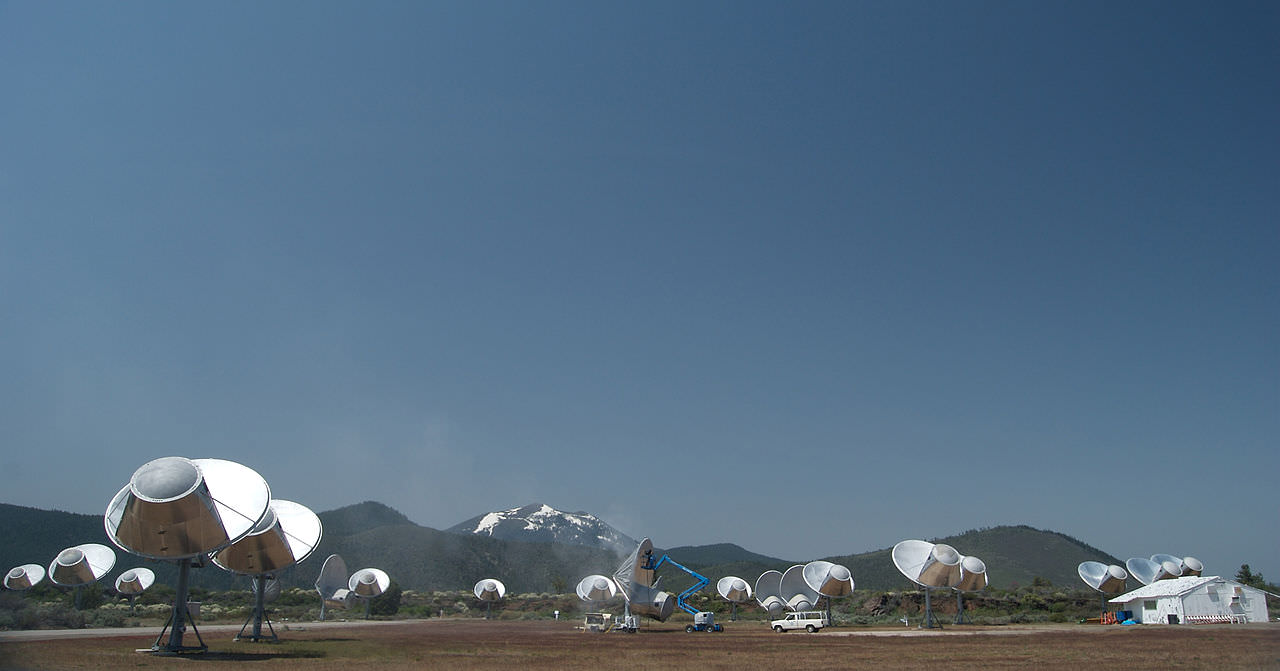
Since it was founded in 1984, the SETI (Search for Extraterrestrial Intelligence) Institute in Mountain View, California, has been a principal American venue for scientific efforts to discover evidence of extraterrestrial civilizations. In mid-November, the institute sponsored a conference, “Communicating across the Cosmos”, on the problems of devising and understanding messages from other worlds. The conference drew 17 speakers from numerous disciplines, including linguistics, anthropology, archeology, mathematics, cognitive science, philosophy, radio astronomy, and art.
This is the second of four installments of a report on the conference. Today, we’ll look at the SETI Institute’s current efforts to find an extraterrestrial message, and some of their future plans. If they find something, just how much information can we expect to receive? How much can we send?
The idea of using radio to listen for messages from extraterrestrials is as old as radio itself. Radio pioneers Nikola Tesla and Guglielmo Marconi both listened for signals from the planet Mars early in the 20th century. The first to listen for messages from the stars was radio astronomer Frank Drake in 1960. Until recently though, SETI projects have been limited and sporadic. That began to change in 2007 when the SETI Institute’s Allen Telescope Array (ATA) started observations.
Consisting of 42 small dishes, the ATA is the first radio telescope in the world designed specifically for SETI. The SETI search is currently managed by Jon Richards, an engineer who is an expert on both the system’s hardware and software. He spoke at the conference about the project. The ATA is currently used for SETI research twelve hours out of each day, from 7 pm to 7 am. During the day, the site is operated by Stanford Research International to perform more conventional astronomical studies. When used for such observations, the dishes can function together as an interferometer, generating images of celestial radio sources. To minimize radio interference from human activities, the telescope is sited a six hour drive north of the SETI Institute at the remote Hat Creek Observatory in the Cascade Mountains of Northern California.
The ATA can detect signals over the range from 1 to 10 GHz. The researchers use several strategies to tell potential ETI signals apart from naturally occurring radio sources in space, and human-made terrestrial interference. Radio emissions from natural sources are smeared over a broad range of frequencies. Artificial signals designed for communication typically pack all of their energy into a very narrow frequency band. To detect such signals, the ATA can resolve frequency differences down to just 1 Hz.
When a radio source is moving with respect to the receiver, it appears to change in frequency. This phenomenon is called the Doppler effect. Because an alien planet and the Earth would be moving in relation to one another, a genuine ETI signal would exhibit the Doppler effect. A source of terrestrial interference that’s fixed to the Earth wouldn’t. If the beam of the telescope is shifted away from the target, a genuine alien signal emanating from a distant point in space would disappear, reappearing when the beam was shifted back. A signal due to local interference wouldn’t.

The ATA is designed to perform these tests automatically whenever it detects a potential candidate signal. To make sure, it repeats the second test five times. If a signal passes the tests, the operator is automatically sent an e-mail, and the candidate signal is entered into a database. Periodically, as a test, the telescope is programed to point in the direction of one of the two Voyager spacecraft. Because these spacecraft are hurtling through deep space beyond the orbit of Neptune, their signals mimic the properties expected from an alien transmission. So far, all the e-mails received have been generated by such tests, and by false alarms. The fateful e-mail announcing the successful detection of an extraterrestrial signal has not yet been sent.
Richards explained that the ATA’s most recent project has been to listen to more than one hundred Earth-like planets discovered by the Kepler space telescope between 2009 and 2012. Next year the ATA’s antenna feeds will get an upgrade that will increase their upper frequency limit to 15 GHz and greatly increase their sensitivity. Both ground-based and Kepler studies have identified numerous Earth-like planets at habitable distances from small dim red dwarf stars. A systematic search of these stars is planned next. If the SETI Institute can find the funding they hope eventually to expand the ATA to 350 dishes.
According to astronomer Jill Tartar, the retired director of the SETI Institute’s Center for SETI Research, the institute is hoping to become involved in a much larger international project; the Square Kilometer Array (SKA). When it begins operations in 2020, the SKA is planned to be the world’s largest radio telescope. It will consist of several thousand dishes and other receivers giving it a radio signal collecting area of one square kilometer. The advantage of having more collecting area is that the telescope is sensitive to fainter signals. If funding allows it to be built in the way currently planned, it will be capable of training multiple simultaneous beams at the sky, some of which Tartar said might be used to mount a continuously ongoing SETI search.

Suppose we did find something. What sort of reply could we send? How much do we have the technological capability to send, if we wanted to? Back in 1974, in the first demonstration of the capacity for interstellar messaging, the Arecibo radio telescope transmitted a mere 210 bytes, and took 3 minutes to do it. The message consisted of a human stick figure and a few other crude symbols and diagrams. Because this primitive effort is still the most well-known example of interstellar radio messaging, prepare yourself for a stunning surprise. According to SETI Institute radio astronomer Seth Shostak, using broadband microwave radio, we could send them the Library of Congress (consisting of 17 million books) in 3 days, and the contents of the World Wide Web (as of 2008) in a comparable time.
Using the shorter optical wavelengths of a laser beam and optical broadband, we could send either one in 20 minutes. Since the extraterrestrials might tune in at any time, we would need to send the transmission over and over again many times. Although our transmissions could be sent in only days or minutes, they would, of course, still take decades or centuries to traverse the light years. This transmission capability presents a stunning opportunity. We can send anything. We can send everything. Could it really be that someday, beings from Tau Ceti will peruse your Facebook page?
So what can we expect from the aliens? Any message we might receive, Seth Shostak thought, would be of one of two possible sorts. A civilization already aware of our existence, he believed, would send us a huge message, rich in information content. This is because even if technological civilizations are fairly common in the galaxy the nearest one might be tens, hundreds, or thousands of light years away. Radio messages traveling at the speed of light will take that long to cross those distances, and decades or centuries will elapse between query and response. If we are contacted, Shostak really does think that we should send the aliens the entire content of the World Wide Web. Civilizations further away than 70 light years from Earth probably wouldn’t know that we exist, because radio signals from Earth haven’t reached them yet. Shostak didn’t think that civilizations would waste precious transmitting time and energy bombarding planets with petabytes of information if they didn’t already know that there was a technological civilization there. Worlds that weren’t known to harbor a civilization, Shostak speculated, might get put on a long list of potentially habitable planets to which the aliens might periodically send a brief “ping” hoping to get a response.
A petabyte of gibberish contains as much information as a petabyte of our world’s greatest art and literature (or tackiest YouTube videos). A petabyte of our world’s greatest art and literature is gibberish to a being who can’t understand it. We could send the aliens truly stunning amounts of information, but can we find some way to ensure that they will understand its meaning? Could we hope to understand an alien message sent to us, or would all those petabytes be for naught? In the next installment, we’ll learn that we face daunting problems.
Part 1: Shouting Into the Darkness
References and Further Readings:
Communicating Across the Cosmos: How can we make ourselves understood by other civilizations in the galaxy, SETI Institute.
N. Atkinson (2012), SETI: The Search Goes On, Universe Today.
S. J. Dick (1996), The Biological Universe: The Twentieth_Century Extraterrestrial Life Debate and the Limits of Science, Cambridge University Press, Cambridge, UK.
S. Hall (2014), Are We Ready for Contact?, Universe Today.
Allen Telescope Array, SETI Institute.
